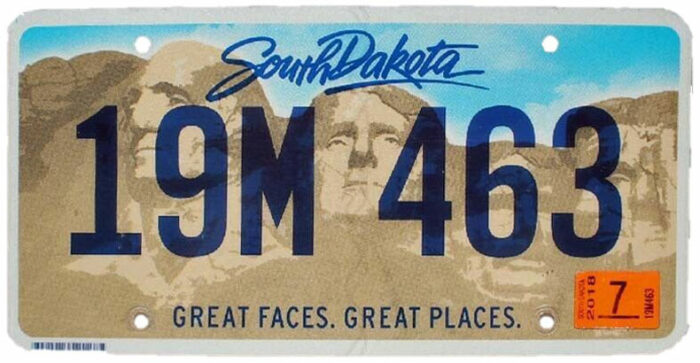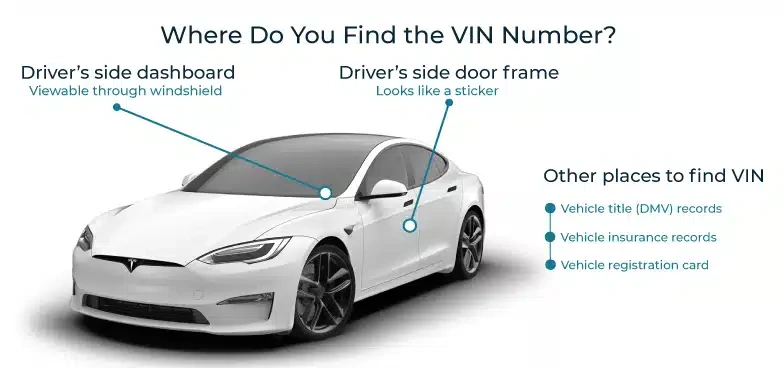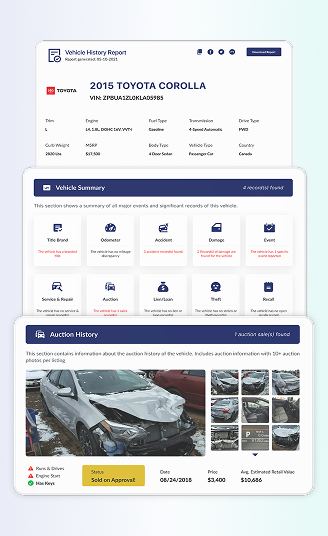South Dakota License Plate Lookup
Purchasing a used vehicle often involves additional steps to prevent scams and avoid problematic cars. Use our South Dakota license plate lookup to gain insights into a used vehicle’s history before you decide to purchase.
Table of Contents
What is a South Dakota License Plate Lookup?
The South Dakota license plate lookup is a tool you can use to look up the license plate and get the vehicle history report before you decide to buy. Through the lookup, you can access a vehicle history report that includes important information such as accident records, auction listings, open recalls, warranty coverage, ownership history, mileage verification, and more.
Can I Get a Free License Plate Lookup in South Dakota?
Yes, you can get a free license plate lookup from our service. However, the information provided in the report differs from that of the fully paid service, as you will only get the basic specifications of the vehicle.
Here’s the information on what you’ll be getting through the vehicle history lookup.
- Associated VIN number
- Year, Make, and Model
- Country of Origin
- Market Value
- Transmission Type
- Fuel Type
- Drive Type
- Body Type
- Trim Information
- MSRP
- Engine Specifications
- Dimensions
- VIN
- Engine Value
- MSRP
- Manufacturer
- Fuel Type
- Body Type
- Year & Model
- Transmission
- Vehicle Type
- Sales Record
- Drive Type
- Mileage
- Market Value
- Doors
- Country of Origin
Why is South Dakota License Plate Lookup Important?
Vehicle cloning scams are now a common crime in South Dakota. Thieves are getting smarter, using the VINs of other cars to scam buyers online and steal the identities of excellent cars to disguise the car’s condition (salvaged and even stolen!).
Performing a license plate lookup is important to avoid such things. While VINs can be tampered with, license plates are where they draw the line. This is a simple yet crucial step to ensure that the vehicle you are about to purchase is legit and in good condition.
Information You Can Get From South Dakota License Plate Lookup
The key difference between paid and free versions of the vehicle history lookup. While free reports offer basic details, paid versions provide a comprehensive view of the car’s history.
Below is the detailed information available in the paid report:
Vehicle Specification
Verify the vehicle’s full specifications, trim, engine type, fuel type, standard seating, MSRP, country of origin, etc. Ensure that the vehicle matches your needs and budget.
Accident History
Access detailed records of past accidents, including the date and the location where the accident took place.
Ownership History
Learn about the car’s previous owners, how long they owned it, the year of purchase, and the location of the vehicle.
Sales Records
Review past ownership changes and sales data to understand the car’s transaction history by checking the sold price of the vehicle.
Auction History
Find out if the car was sold at auction, which could indicate quality issues or market interest. See the location, date, and the final price of the vehicle during the auction. Also, you can get up to ten pictures that show the vehicle’s condition during the auction.
Title Status
Verify whether the title is clean, salvaged, rebuilt, or branded to assess its legal and physical status. Make sure that the vehicle’s title is clean before you buy the vehicle.
Lien/Loan Records
Check for existing liens or unpaid loans that might complicate ownership transfer. See if the lien/loan is still tied to the vehicle and make sure it’s cleared by the previous owner.
Open Recalls
Identify any unresolved safety recalls or defects that require attention. In this section, you’ll see the date of recalls, the causes, and the steps taken to ensure the issues are resolved.
Theft Records
Confirm that the vehicle has not been reported stolen to ensure its legitimacy. If the vehicle has a stolen record, you’ll get the detailed information on the date, location, and the data source.
Odometer Reading
Validate the mileage to check for accuracy and estimate the car’s usage and wear. See the recorded mileage and the date, as well as the last recorded mileage of the vehicle.
Service and Maintenance History
Examine past repairs and servicing records to understand how well the vehicle was maintained. Check the date, location, and what service or maintenance was performed on the vehicle.
Warranty Coverage
Check if the vehicle is still covered by warranty. See the mileage and months of limit of each warranty, like: basic, powertrain, maintenance, roadside assistance, and more.
Why is Getting a Vehicle Report in South Dakota is important?
A buyer wanted to buy a 2013 GMC YUKON from a private seller. Before he paid for the down payment, he decided to use the Dakota license plate lookup to get the report. Here’s what he saw on the report.
Actual Condition
- 2 accident records
- 1 Record(s) of damage
- 2 specific events reported
- 2 auction records
- 7 lien or loan record
Seller’s Claim
- Privately used
- Never been in an accident
- Has no major damage
- Never been in an accident
Actual Condition
- To check if the vehicle has ever been in an accident or has extensive damage
- Make sure that it’s all worth the money
Outcome
- The buyer decided not to buy the vehicle because it has too many red flags.
How Does the License Plate Lookup Work in South Dakota?
To perform a license plate lookup, follow these steps to get your report instantly through the South Dakota License Plate Lookup.
Enter the License Plate Number
First of all, find the license plate number of the vehicle you want to purchase. If you do not have it, ask the seller/salesperson directly.
Fill Out the Form
Write down the license plate number on the form above and click the button to submit the form.
Lookup MI License Plate
Wait for seconds for the report to be generated, proceed to payment, and then you will get the full vehicle history report.
Why Choose Detailed Vehicle History for South Dakota License Plate Lookup?
- Affordable reports: Get detailed vehicle history at a budget-friendly price.
- Comprehensive details: Access accident records, auction history, past owners, recalls, mileage, and more.
- Auction photos: View up to 10 images from previous auctions to better understand a vehicle’s condition.
- No expiration: Once purchased, reports can be revisited anytime without extra cost.
- Trusted by buyers and sellers: A reliable way to verify vehicle details and avoid scams before making a deal.
License Plate Regulations in South Dakota
Through its Motor Vehicle Division, the South Dakota Department of Revenue is responsible for issuing, renewing, and governing license plates. It requires putting the license plate on the front and rear sides of the vehicle. The dual-plate allows the authority to identify the vehicle easily. Make sure your plate is clean of debris or snow to be easily identified. However, motorcycles and trailers are only required to display a rear plate.
Vehicle Types That Should Have a License Plate
All motor vehicles operating on the road must have two license plates placed according to the rules, including:
Passenger cars
Trucks
Motorcycles (rear plate only)
Trailers (rear plate only)
Specific requirements may apply to certain vehicle types, such as historic motor vehicles, which may be permitted to display a single original number plate securely fastened to the rear of the vehicle in a horizontal and upright position.
Types and Design of License Plate

The standard license plate of South Dakota features the legendary statue of the previous presidents of the U.S. in navy blue lettering and the slogan “Great Faces, Great Places,” which represents the famous tourist attraction Mountain Rushmore.
Types of License Plates in South Dakota
South Dakota offers a variety of license plates to meet the needs of vehicle owners. These plates range from standard designs to personalized options.
Standard Plates
Standard license plates are issued to most passenger vehicles, trucks, and motorcycles. They are simple in design and combine letters and numbers for unique identification.
Personalized Plates
Personalized plates allow vehicle owners to create a custom message or combination of letters and numbers, provided it meets state guidelines. Personalized plates can reflect names, hobbies, or other personal interests.
Historical Plates
Specialty plates promote organizations, professions, or causes. These include:
- Organizational Plates: Available for members of specific organizations, such as professional groups or clubs.
- Military Plates: Recognizing the service of veterans and active-duty military personnel.
- Charity Plates: Supporting causes like education or wildlife conservation.
Antique and Historical Plates
Vehicles over 30 years old can apply for antique or historical plates. These plates highlight the vehicle’s age and are often issued to collectors.
Dealer and Transporter Plates
Dealer plates are used for vehicles owned by dealerships. Transporter plates are issued for vehicles in transit or temporarily moved.
For more details on South Dakota’s license plate options, visit the South Dakota Department of Revenue.
License Plate Cost in South Dakota
- Standard passenger plates: included with registration (no separate plate fee).
- Personalized plates (vanity): $25/year plus regular plate fee, South Dakota Department of Revenue.
- Specialty plates: an additional $10–$25, depending on type, plus $7.50 mailing fee.
How to Register and Transfer a Car Title in South Dakota
Transferring title in South Dakota involves both the seller and buyer completing paperwork and submitting it to the county treasurer or state DMV.
Here are the steps you can follow.:
- Completing the MV-608 Title & Registration form with required fields.
- Seller signs over the current certificate of title with odometer disclosure if required
- Buyer submits proof of lien release (if applicable), ID, and pays title transfer fee ($10) plus excise tax (4% of sale price).
- If plates are not transferred, new South Dakota plates must be requested.
How to Transfer License Plates in South Dakota
In South Dakota, plates generally do not move with the sold vehicle; the buyer obtains new plates. However, if you are trading vehicles you already own, you may retain or transfer your plate following proper procedures:
Fun Facts about South Dakota
Dakota offers a wide range of color choices to diversify its population. Dakota is available in black, white, red, brown, and blue compared to the other states. This diversity adds uniqueness to the states’ license plates.
Other Vehicle Check Tools
Before purchasing, verify a car’s history, factory details, and ownership records with these essential tools.
VIN Decoder
Window Sticker Lookup
Build Sheet by VIN
Classic Car History Report
License Plate Lookup By States
Our license plate lookup service covers other states, as listed below.
Frequently Asked Questions About South Dakota License Plate Lookup
Q. Can someone report your license plate?
A. You can report it, but it’s unlikely the police will do much. They usually only give tickets for things they see happen.
Q. What do you do with old license plates in South Dakota?
A. You keep your old license plates when buying a new car in South Dakota. Because South Dakota is an “owner plate” state, you transfer the plates from your previous vehicle to your new one.
Q. Can out-of-state residents register their cars in South Dakota?
A. South Dakota permits out-of-state residents to title and register their vehicles, trailers, watercraft, ATVs/off-road vehicles, or snowmobiles. The state’s titling and registration laws do not specifically exclude non-residents.


